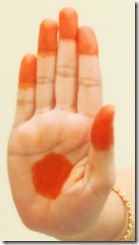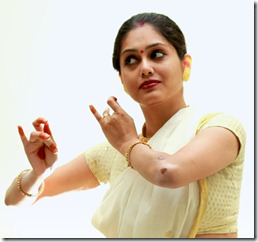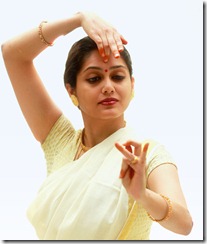Continued from [Mudras/Hastas in Mohiniyattam – I]
Mudras can be called the alphabets of classical dance which help in conveying expressions more profoundly. Alphabets form words, similarly, combining Mudras forms meanings. Hence these combinations of Mudras are divided into three:
Mudras can be called the alphabets of classical dance which help in conveying expressions more profoundly. Alphabets form words, similarly, combining Mudras forms meanings. Hence these combinations of Mudras are divided into three:
- Asamyuktha Mudras: Showing a Mudra with just one hand. E.g. Showcasing 'woman' with the Hasta Katakam
- Samyuktha Mudras: Showing the same Mudra on both hands. E.g. Showcasing the 'King' - having the Hasta Pataka on both hands.
- Sankalana Mudras: Showing different Mudras on both hands at the same time or showing different Mudras with the same hand. E.g. Showcasing the 'Cow' – Katakam on the left hand & Pathaka on right hand. The 'Tree' – Hold Araala first and then followed by Soochikamukha.
The table below gives a small description of the various uses of the 24 Mudras according to the classification above:-
| Hastas |
Asamyuktha Hasta
|
Samyuktha Hasta
|
Sankalana Hasta
|
Pathaka
 |
Singing, Way, Throat, Distance, Tongue, Forehead, Day, Ray of Light
|
Earth, King, Sun, Wind, Ox, Lion, Creeper, Vessel, Crown, Devotee, Companion, Path, Foot, Seat, Crocodile, Hell, Banner, Body, Door, Wedding, Sweet
|
Dance, Dancers, Elephant, Shepherd, Empire, Cow, Night
|
Mudrakya
 |
Desire, Doubt, Announcement, Heart, Thought, Knowledge, Peak
|
Mind, Sacred Thread worn by Brahmins, Movement, Everything, Life, Clothes, Sage
|
Ocean, Heaven, Equal, Saying No, Blow, Grow, Noble Person, Happiness, Virtue, Slightly, Hence, Death, Forget, Wealth
|
Katakam
 |
Woman, Mirror, Bracelet, Fragrance
|
Krishna, Vishnu, Stars, Blue Lotus, Anklet, Waistband, Gold, Silver, Flower Garland, Holy Sacrifice, Lakshmi, Chariot, Sleeping, Precious Stone, Arrow, Ear Rings
|
Flower Arrow belonging to Kamadeva, Veena, Flower, Lord Ram, An Asura (Demon), Garden, Playing, Female Cuckoo, Beautiful Girl, Little Girl, Daughter
|
Mushti
 |
Bow, Courageous Man, Asking what/ why/ how
|
Good Quality, Strength, Describing, Wear, To Start, Pulling
|
Mountain, Rising, Sunset, to give birth, to abandon, to mock, to tolerate, to stay, Father, Lord Indra, Truth, the most, to bless, to tie, Win, Cursing, to accept
|
Kartharimukha
|
Speak, Hear, Procrastinate, Human, Come, Slowly
|
Brahmin, Listen, Fame, Sin, Hunger, Cold, Animosity, Boy
|
Family, People, Nearby, Face, Open space, Parasuraman, Commencement, Home, Girl, Imagination, Addressing you, Addressing by Name
|
Shukathunda
 |
Bird, Hook
|
Decision, Quarrel
|
Male Parrot, Female Parrot
|
Kapitha
 |
Showing Two
|
Reason, Inquiring, Fault, Climbing, Drinking, Walking
| |
Hamsapaksha
 |
Me, Enough, Saying No, To lie down, Saying before, Hair
|
To bow, Matted Hair, Betrayal, Sandalwood Paste, Lord Manmata, To fill up, To save, Fish, Saying No, Addressing someone with respect, Laying the bed, Friendship, The Gods, Cheek
|
Moon, Lord Manmatha (Kamadeva - The God of Love), To Kill, Moonlight, To understand, Lord Shiva, Anger, Bless, Hair, to beg
|
Shikharam
 |
Eyes, Mark on the forehead, Lightning
|
Walking, Climber
|
Centre, Lord Indra, To See
|
Hamsasya
 |
Odour
|
Colour, Rice, Mercy, Love, Soft, Dust
|
Lips, Lover (Male & Female), Lotus Stalk
|
Anjali
 |
To Give, To receive, Bowing to God, Bowing to one’s Guru (Teacher), Deer, Worship, Retching
| ||
Ardhachandra
 |
Asking who/ when/ where/ how, Mind, Insult, Leaf
|
Happiness, Fatigue, Lake
|
Noble person, Laughter, Smile, Beauty
|
Mukhuro
 |
Bee, Enemy
|
Separation from dear ones
|
Brother, Right Method
|
Bhramaro
 |
Song, Exists, Drink holy water
|
Peacock, Rain, Cloud, Fear, Water, River, wings, Elephant Ears, Crying
| |
Soochikamukha
 |
Showing someone, Saying like that, Proper, showing the number One, Difficulty, Forehead, showing the world, showing quietness, showing eyebrows, showing something else, Crying, Drowsiness
|
Proper, Showing one by one, Showing a get-together, World, Climate, Break, Fall down
|
Tree, Death, Listen, Showing slightly, Hence, Beauty
|
Pallava
 |
Plastering, Saying Now, Food offered to Gods, Any Offering to Deity, Far, Enemy
|
Book, Peak
| |
Tripathaka
 |
Saying No
|
Conversing with God, Gods
| |
Mrigashirsha
 |
Animal, Salt reed grass
|
Supreme being, Lotus petal
| |
Sarpashiras
 |
Snake, Child
|
Elephant Head, Gift, Serpent Head, Flower Offering, Drinking water, Snakes
|
Food for animals
|
Vardhamanaka
 |
Lower lip, Kind of mark on the forehead, oblation to ancestors
|
Honey, Jewel
| |
Araala
 |
Cruel Man, Pride, Teeth, Bud, Showing the round shape of the Full Moon, To Think
|
Poison, Sin, Plant
|
Tree
|
Oornanabha
 |
Ball
|
Snow, Lake,Fire, Light, Lotus, Horse, Heat, Jackal
|
Blooming of a flower, To play, Beauty, Garden, Roar, Crying aloud
|
Mukula
|
Eat, Mongoose, the number 5, Monkey, To wither
|
Luck, Purity, Auspicious Deed
|
Smile, Shepherd
|
Katakamukha
 |
Heart, Ascetic’s water pot
|
Domestic Help, Intoxication, Warrior, Tied Up
|
To Kill, War
|
Mudras for the Gods
Name of Gods
|
Right Hand
|
Left Hand
|
Brahma
(The Creator)
|
Hamsapaksha
|
Katakam
|
Ganapathi
(Lord of Beginnings and Remover of Obstacles)
|
Pathaka
|
Katakamukha
|
Subramanian/
Muruga(God of war and victory)
|
Kartharimukha
|
Kartharimukha
|
Agni
(God of Fire)
|
Mukula
|
Mukula
|
Agni (God of Fire)
|
Oornanabha
|
Oornanabha
|
Yama
(God of Death)
|
Katakamukha
|
Katakamukha
|
Varuna
(God of Water & Sky)
|
Mudrakya
|
Mudrakya
|
Varuna
(God of Water & Sky)
|
Pathaka
|
Pathaka
|
Vayu
(God of Wind)
|
Hamsapaksha
|
Hamsapaksha
|
Kubera (God
of Wealth)
|
Kataka
|
Kataka
|
Saraswathi
(Goddess of Knowledge, Music, Arts and Science & Brahma’s consort)
|
Kataka
|
Kataka
|
Parvati
(Lord Shiva’s consort)
|
Kataka
|
Mrigashirsha
|
Vishnu
(The Preserver)
|
Kataka
|
Kataka
|
Shiva
(The Destroyer/ Transformer)
|
Tripathaka
|
Mrigashirsha
|
Mudras for Dasavatar
Right Hand
|
Left Hand
| |
Matsya (Fish)
|
Hamsapaksha
|
Hamsapaksha
|
Koorma (Tortoise)
|
Clasping both the hands and bending the middle fingers
| |
Varaha (Boar)
|
Anjali
|
Anjali
|
Narasimha (Half Man – Half Lion)
|
Pathaka
|
Kartharimukha
|
Vamana (Dwarf)
|
Katakamukha
|
Mushti
|
Parashurama
|
Kartharimukha
|
Mushti
|
Sri Ram
|
Kataka
|
Mushti
|
Balarama
|
Kataka
|
Kataka
|
Sri Krishna
|
Kataka
|
Kataka
|
Kalki
|
Mushti
|
Oornanabha/Katakamukha
|
Mudras for Relatives
Relative
|
Right Hand
|
Left Hand
|
Father
|
Hold Mudrakya & then leave
|
Mushti
|
Mother
|
Kataka
|
Kataka
|
Son
|
Hold Mudrakya & then leave
|
Kartharimukha
|
Daughter
|
Hold Mudrakya & then leave
|
Kataka
|
Female Friend
|
Pathaka
|
Kataka
|
Male Friend
|
Pathaka
|
Pathaka
|
Husband
|
Mushti
|
Mushti(Thumb should rise)
|
Wife
|
Hold the left hand
|
Mukula
|
Older Brother
|
Mudrakya
|
Mushti
|
Younger Brother
|
Mukura
|
Mushti
|
Sister
|
Mukura
|
Kataka
|
A noticeable factor in the above Mudras representing relatives are that the female relatives have Kataka as a common Mudra while for male relatives, the Mushti Mudra is most common.
Mudras for Certain Mythological Characters
Character
| Right Hand | Left Hand |
|
(Main Antagonist in the Ramayana)
|
Pathaka
|
Kartharimukha
|
|
(Eldest Kaurava – Main Antagonist in the Mahabharata)
|
Pathaka
|
Kartharimukha
|
|
(Duryodhana’s brother)
|
Pathaka
|
Araala
|
|
(Eldest Pandava – Protagonist in Mahabharata)
|
Pathaka
|
Mudrakya
|
|
(2nd Pandava)
|
Pathaka
|
Katakamukha
|
|
(A Villain in the Mahabharata)
|
Mushti
|
Mushti
|
|
(Monkey King who assisted Sri Rama in the Ramayana)
|
Pathaka
|
Mukula
|
|
(Illegimate son of Queen Kunti {mother of Pandavas} in the Mahabharata)
|
Kataka
|
Kataka
|
|
(Son of Brahma)
|
Hamsapaksha
|
Mushti
|
|
(Older of brother of Sugriva - slain by Sri Rama in the Ramayana)
|
Pathaka
|
Mukula
|
|
(Monkey God & ardent devotee of Sri Rama in the Ramayana)
|
Hamsapaksha
|
Hamsapaksha
|
Some of the character representations are the same in the above table. For E.g. Ravana & Duryodhana have the same Mudras but this can be identified in accordance to the narration or the story which is being depicted.






























